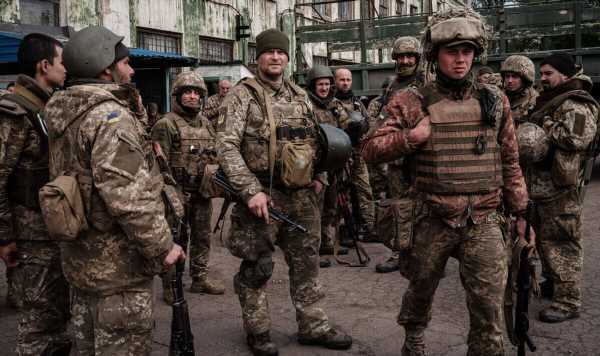UK’s training 20,000 Ukrainians for spring offensive against Russia

Britain is training 20,000 Ukrainian recruits every five weeks in a frantic push ahead of President Volodymyr Zelensky’s Spring offensive against Russian forces. Such is the fierce momentum of the drive – codenamed “Operation Interflex ” – that commanders are being forced to pause elements of regular training for British forces, sources said.
More than 4,000 British soldiers attached to the Irish and Welsh Guards as well as the Royal Marines and Mercian, Rangers, Rifles and Royal Anglian regiments are involved in the training package which is being overseen by 11th Security Assistance Brigade.
Training grounds including Salisbury Plain, Hankley Common, Longmoor, Catterick and Otterburn have been completely taken over for the task.
So far, nearly 60,000 Ukrainian troops have already gone through Op Interflex since last summer, though the tempo was increased after PM Rishi Sunak boosted it from 10,000 – 20,000 per month earlier this year.

Britain also became the first ally to train Ukrainian pilots in Nato airspace tactics, though Sunak drew the line at providing fastjets.
Ukrainian recruits are being taught a range of war skills in 35-day training missions, from rural and urban warfare, Counter IED. medical trauma to surviving in a hostile environment, weapons handling, marksmanship and the law of armed conflict.
On Salisbury Plain Ukrainian troops are being taught to direct artillery and coordinate air strikes using AS-90 self-propelled artillery guns donated by Britain. The 155mm mobile artillery system is capable of firing up to six rounds per minute.
The vast area in Wiltshire is also being used for armoured infantry training, live firing with General Purpose Machine Guns and specialist sniper training after the UK donated thousands of GPMG guns, sniper rifles and ammunition.
At Longmoor in Hampshire Ukrainian soldiers are mentored on routine patrols, while at Hankley Common in Surrey – from which members of the public have now been banned to accommodate low flying Chinook helicopters – they take part in assaults on fake Russian positions in dawn attacks.
Others are being taught to fly helicopters, operate drones at night, and take part in close quarter fighting in simulated villages.
A final week-long exercise which tests their training takes place in Salisbury.
Instructors have been flown in from Canada, Denmark, Finland, Lithuania, the Netherlands and Norway, Sweden, Australia and New Zealand to assist British trainers.

A senior military source has confirmed that Ukrainian training has now become the Ministry of Defence’s “main priority”.
“Everything they need, they are getting – a full spectrum of equipment, weapons, ammunition plus round-the-clock training programmes,” said the source.
“These recruits range from professionals – accountants, lawyers and businessmen- to taxi drivers. While most are young, some are in their 40s. But they all have one thing in common: they are all lion hearts, with a real desire to fight for their country.
“They are here for five weeks and then they fly back to Poland and go straight into action.”
The effort, combined with a shortage of donated munitions, is taking its toll on conventional training
At Catterick garrison, for instance, hand grenades are in short supply for recruit training, N-LAWS are almost non-existent and there is a shortage of live ammunition.
The source added: “This has all impacted on routine training for UK battalions, but we just have to ride the storm.”
Ukraine continues to hang on in the city of Bakhmut, even as Russian forces threatened a key resupply route.
“Ukraine’s key 0506 supply route to the west of the town is severely threatened,”said a British intelligence update.
President Zelensky confirmed last week that if his troops came under risk of encirclement they would pull back from Bakhmut – one of the last urban centres in Ukraine’s eastern Donetsk province yet to fall to Russian forces.
It is feared that the fall of Bakhmut would give Russian forces “an open road” to two bigger cities in Donetsk – Kramatorsk and Sloviansk.
But the capture by Russian forces of Ukraine’s main artery for supplies and the evacuation of injured troops would spell the end of resistance there.
In other news, Russia’s bid to degrade Ukraine’s energy system has “most likely failed’, a Ministry of Defence intelligence update said.
Though Russia has been conducting missile strikes on Ukrainian infrastructure since October 2022, large-scale long-range attacks have become increasingly rare since March.
In the meantime, Ukraine’s network operating companies continue to source replacement transformers and other critical components, said the report, adding: “Transporting and installing these components is a major logistical challenge, especially high voltage transformers which weigh at least 100 tonnes.”
The report goes on to say that Ukraine’s energy situation “will likely improve” with the arrival of warmer weather.
Source: Read Full Article

